Pecharsky V.K., Zavalij P.Y. Fundamentals of Powder Diffraction and Structural Characterization of Materials
Подождите немного. Документ загружается.

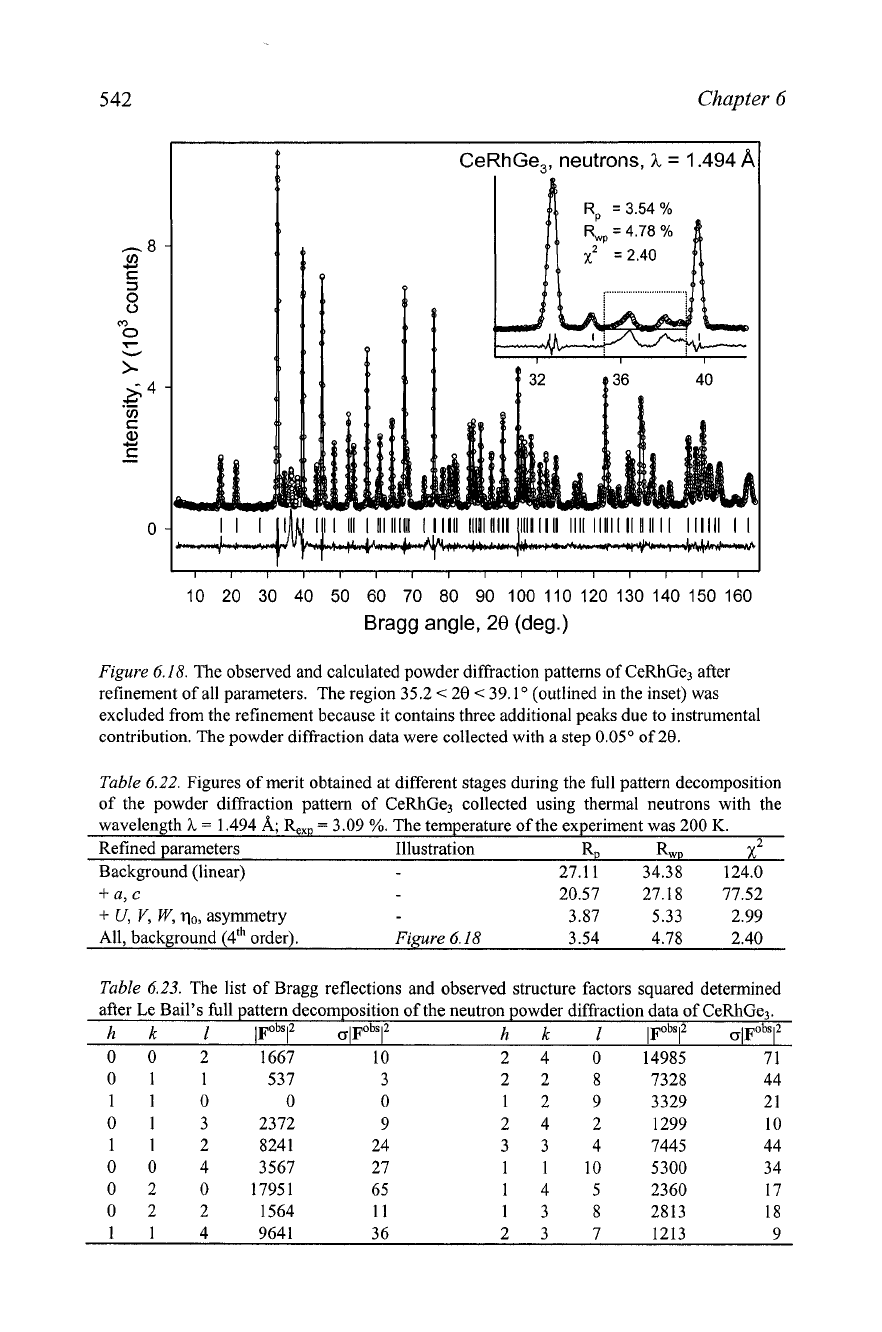
Chapter
6
CeRhGe,, neutrons,
h
=
1.494
a
8l,,,,,,#C8#,,#L
10 20 30 40 50 60 70 80 90 100 110 120 130 140 150 160
Bragg angle,
28
(deg.)
Figure
6.18.
The observed and calculated powder diffraction patterns of CeRhGe3 after
refinement of all parameters. The region
35.2
<
28
<
39.1
(outlined in the inset) was
-
excluded from the refinement because it contains three additional peaks due to instrumental
contribution. The powder diMaction data were collected with a step
0.05'
of
20.
Table
6.22.
Figures of merit obtained at different stages during the full pattern decomposition
of the powder diffraction pattern of CeRhGe3 collected using thermal neutrons with the
wavelength
h
=
1.494
A;
Re,,
=
3.09
%.
The temperature of the experiment was
200
K.
Refined parameters Illustration RD RwD
2
Background (linear)
27.11 34.38 124.0
+
a,
c
20.57 27.18 77.52
+
U,
V,
W,
rlo,
asymmetry
3.87 5.33 2.99
All, background
(4'h
order).
Figure
6.18
3.54 4.78 2.40
Table
6.23.
The list of Bragg reflections and observed structure factors squared determined
after Le Bail's full pattern deEomposition of the neutron powder diffraction data of CeRhGe3.
h
k
1
IF"^"^
(rlFObS12
h
k
1
IF^^^^^
OIF~~~~~
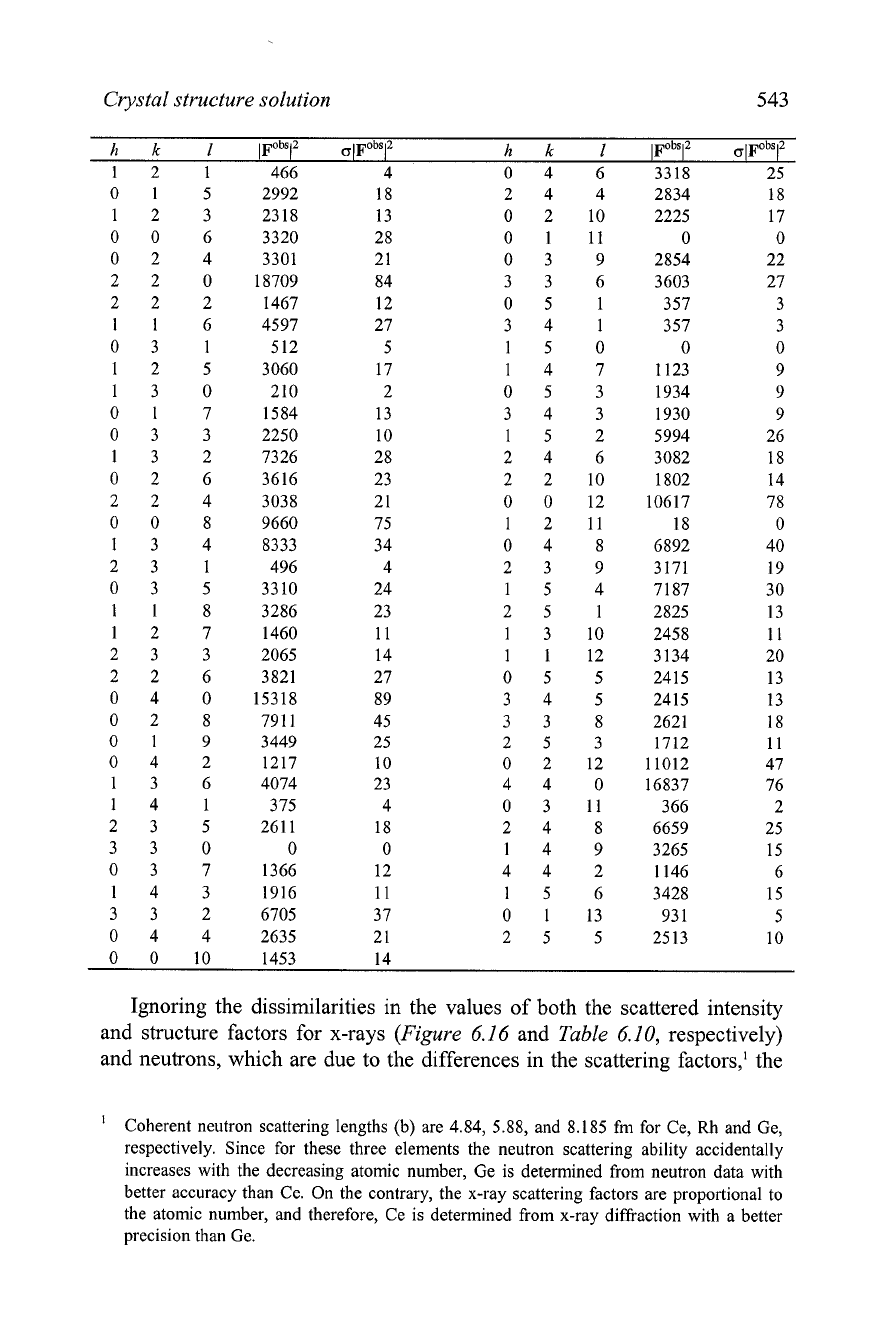
Crystal structure solution
543
Ignoring the dissimilarities in the values of both the scattered intensity
and structure factors for x-rays (Figure
6.16
and Table
6.10,
respectively)
and neutrons, which are due to the differences in the scattering factors,' the
'
Coherent neutron scattering lengths (b) are 4.84, 5.88, and 8.185 fm for Ce,
Rh
and Ge,
respectively. Since for these three elements the neutron scattering ability accidentally
increases with the decreasing atomic number, Ge is determined from neutron data with
better accuracy than Ce. On the contrary, the x-ray scattering factors are proportional to
the atomic number, and therefore, Ce is determined from x-ray diffraction with a better
precision than Ge.
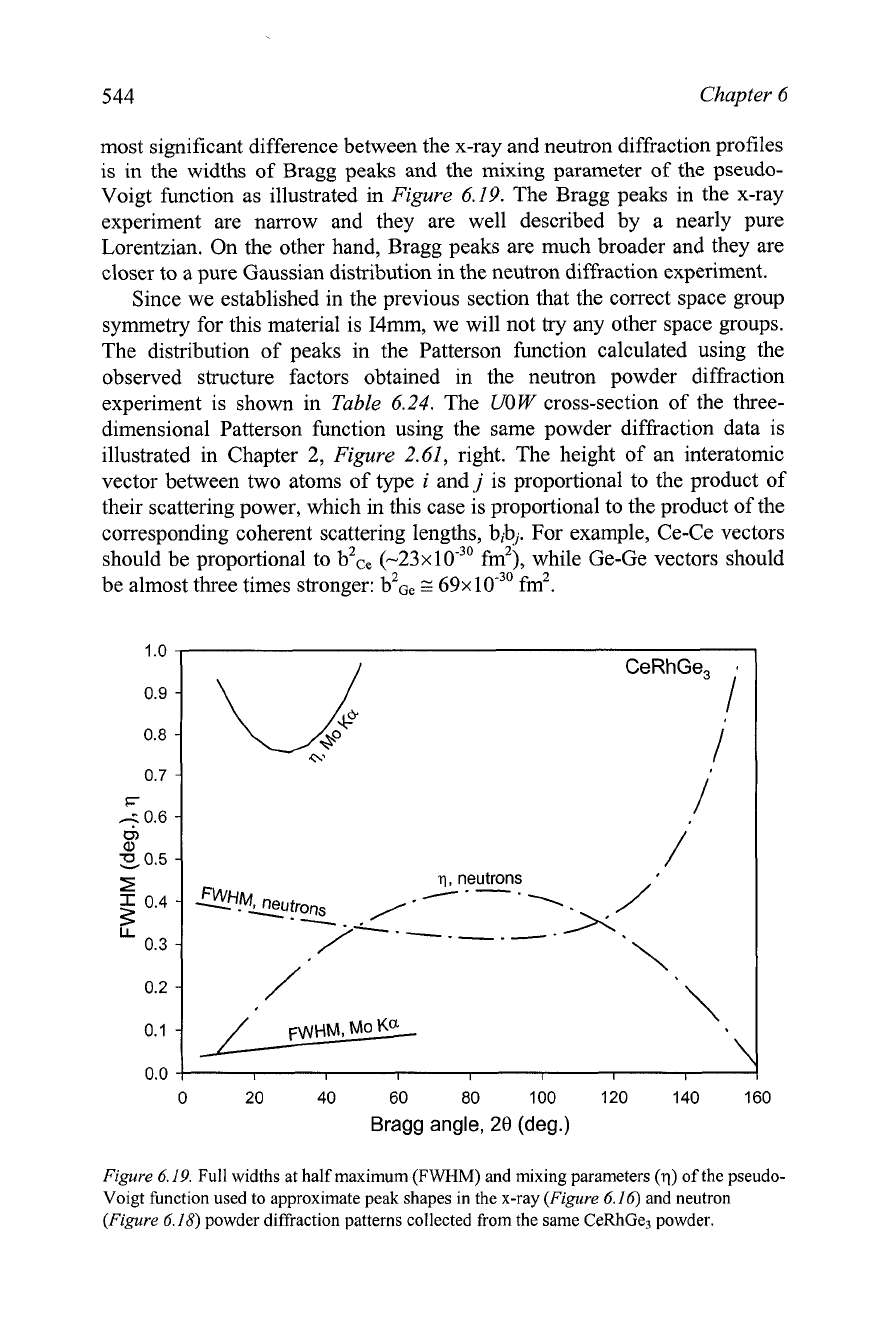
544
Chapter
6
most significant difference between the x-ray and neutron diffraction profiles
is in the widths of Bragg peaks and the
mixing
parameter of the pseudo-
Voigt function as illustrated in
Figure
6.19. The Bragg peaks in the x-ray
experiment are narrow and they are well described by a nearly pure
Lorentzian. On the other hand, Bragg peaks are much broader and they are
closer to a pure Gaussian distribution in the neutron diffraction experiment.
Since we established in the previous section that the correct space group
symmetry for this material is
I4mm, we will not
try
any other space groups.
The distribution of peaks in the Patterson function calculated using the
observed structure factors obtained in the neutron powder diffraction
experiment is shown in
Table
6.24. The UOW cross-section of the three-
dimensional Patterson function using the same powder diffraction data is
illustrated in Chapter 2,
Figure
2.61, right. The height of an interatomic
vector between two atoms of type
i
and
j
is proportional to the product of
their scattering power, which in this case is proportional to the product of the
corresponding coherent scattering lengths, bibj. For example, Ce-Ce vectors
should be proportional to b2C, (-23~10-~' fm2), while Ge-Ge vectors should
be almost three times stronger: b2G,
E
69x10-~' fm2.
0 20 40 60 80 100 120 140 160
Bragg angle,
29
(deg.)
1 .o
0.9
:
0.8
0.7
-
F
6
0.6
-
0
a,
z0.5
-
2
5
0.4
-
LL
0.3
-
0.2
-
Figure 6.19.
Full widths at half maximum
(FWHM)
and mixing parameters
(q)
of the pseudo-
Voigt function used to approximate peak shapes in the x-ray
(Figure 6.16)
and neutron
(Figure 6.18)
powder diffraction patterns collected from the same CeRhGe3 powder.
CeRhGe3
i
a'
i
1,
q,
neutrons
./---
,
/'
zH?.
neutrws
,
---
I/'
/--------
A.
,/'
\,
0.1
-
FwHM, M0
Ka
\,
\

Crystal structure solution
545
Table
6.24.
The three-dimensional distribution of the interatomic vectors in the symmetrically
independent part of the unit cell of CeRhGe, calculated using the observed structure factors
determined from Le Bail's extraction employing neutron diffraction data
(Table
6.23).
Patterson map peak number
u
v
w
Peak height
1
0 0 0 6000
2
0 0 0.5 2675
3 0.5 0 0.355 1500
4
0.5 0 0.145 1500
5
0.5 0 0.250 1500
6
0 0 0.237 1124
7
0 0 0.346 687
8
0 0 0.404 489
9
0.125 0.125 0.088 266
10
0.218 0.21
8
0.457 260
Only the eight strongest independent peaks in
Table
6.24 (highlighted in
bold) have meaningful lengths between -2.4 and 5
A.
The differences in the
heights of Patterson peaks between
Table
6.24 and
Table
6.11 are expected
because now Ge atoms are the strongest scattering species (see previous
paragraph). Between the two sites (see
Table
6.16) that may accommodate
six Ge atoms, the 2(a) site results in the 0,0,0 vector, and the 4(b) site yields
one additional 1/2,1/2,0 vector. Indeed, the second strongest vector found in
Table
6.24 is identical to the latter (0,0,1/2
+
1/2,1/2,1/2
=
112,112,O). Thus,
the Patterson function points to a strongly scattering atom in the 4(b) site of
the space group I4mm. Since the origin of coordinates here is not fixed along
the Z-axis, we may choose any z-coordinate for the Ge atom in this site.
Assume that four Ge atoms are located in
4(b) with z
=
0.000. Let's
try
to
use the Patterson function
(Table
6.24) and locate a second Ge, which should
be in a two-fold site because there is a total of six Ge atoms in the unit cell.
The coordinates of a point in 2(a) are 0,0,z. Hence, the corresponding vector
between the two independent Ge atoms should be
1/2,0,0
-
0,Oq
=
1/2,0,-z
=
112,Oq due to a mirror plane perpendicular to
Z
at z
=
112, which is present in
the space group I4lmmm that describes Patterson symmetry.
A
second vector
can be found from 1/2,0,0
+
1/2,1/2,1/2
-
0,0,z
=
0,112,112-z. Given the
presence of a four-fold axis parallel to
2,
this vector is identical to 1/2,0,1/2-
z. These are vectors No. 3 and 4 in
Table
6.24 assuming z
=
0.355 (or
z
=
0.145). Without other atoms in the model of the crystal structure, the two
choices are equivalent, and any of the two z-coordinates may be selected to
represent Ge atom in the 2(a) site. Thus, the two independent Ge atoms,
according to the Patterson function, are as follows: 4Gel in 4(b):
112,0,0.000, and 2Ge2 in 2(a): 0,0,0.355. The corresponding residual
RF
=
29.0
%.
The coordinates of peaks found on the three-dimensional Fourier
map calculated using phase angles determined from this partial model of the
crystal structure are listed in
Table
6.25.

546
Chapter
6
Table 6.25. The three-dimensional nuclear density distribution in the symmetrically
independent part of the unit cell of CeRhGe3 calculated using the observed structure factors
determined from Le Bail's extraction (Table 6.23) and phase angles determined by Ge in
4(b)
with
z
=
0.000
and Ge in 2(a) with
z
=
0.355
in the space group
I4mm
(RF
=
29.0
%).
Fourier map peak number
x
Y
z
Peak height
1 0
0
0.355 73
2
0.5 0 0
63
3 0 0 0.754 18
4 0
0
0.587 15
5 0 0 0.1
19
I1
6
0 0 0.921 10
The next strongest peak (No. 3) also belongs to the 2(a) site with the
coordinate
z
=
0.754. Its shortest interatomic distances are
=
3.30 and
3.36
A
and
63-Ge2
=
3.27
A.
All three correspond to Ce rather than to Rh,
even though Ce is a light scattering atom when compared to
Rh.
Thus, after
placing 2Ce in 2(a) with
z
=
0.754, the RF
=
19.8
%
and the subsequently
calculated Fourier map is illustrated in
Table
6.26.
Table 6.26. The three-dimensional nuclear density distribution in the symmetrically
independent part of the unit cell of CeRhGe3 calculated using the observed structure factors
determined from Le Bail's extraction (Table 6.23) and phase angles determined by Ge in
4(b)
with
z
=
0.000,
Ge in 2(a) with
z
=
0.355,
and Ce in 2(a) with
z
=
0.754
in space group I4mm
(RF
=
19.8
%).
Fourier map peak number
x
Y
z
Peak height
1
0
0
0.353
6
1
2
0.5 0 0 5 5
3
0
0
0.758
29
4
0 0 0.580 13
5
0 0 0.113 10
G
0.5 0 0.258 7
So far three atoms have been confirmed, and the fourth strongest peak
points to an atom that also belongs to the 2(a) site with
z
=
0.580. The only
atom, which is missing fiom our model, is
Rh.
When 2
Rh
atoms are placed
in this site, the interatomic distance
8Rh-Ce
=
1.75
A,
which is too short. The
fourth peak is therefore, a false maximum and it should be discarded.' After
the next strongest peak (No. 5) is tested, all distances are normal. The RF
=
16.3
%
and the subsequent Fourier map is listed in
Table
6.27, which now
displays a sharp drop in peak heights after peak No. 4. The cross-section of
'
False peaks may sometimes be stronger than the real peaks on the Fourier map, especially
when a structural model is incomplete and/or structure factors accuracy is relatively low,
which is the case here. One atom, which is still missing from the model, is
Rh;
it is the
second strongest scattering atom and, therefore, phase angles are relatively imprecise thus
causing the appearance of a strong false peak.

Crystal structure solution
547
the nuclear density distribution in the
XOZ
plane calculated using the same
powder diffraction data is shown in
Figure
2.59,
right, in Chapter
2.
It is
worth noting that
Figure
2.59
represents a different origin of coordinates
since its selection along the Z-axis is arbitrary in this space group symmetry.
Table 6.27. The three-dimensional nuclear density distribution in the symmetrically
independent part of the unit cell of CeRhGe, calculated using the observed structure factors
determined from Le Bail's extraction (Table 6.23) and phase angles determined by Ge in
4(b)
with
z
=
0.000, Ge
in
2(a) with
z
=
0.355, Ce in 2(a) with
z
=
0.754, and
Rh
in 2(a) with
z
=
0.1 13 in the space group I4mm (RF
=
16.3
%).
Fourier map peak number
x
Y
z
Peak height
1
0 0 0.349 48
2
0.5 0 0 47
3
0 0 0.108 3 3
4
0 0 0.759 24
5
0 0 0.233
G
G
0 0 0.000 3
Since we did not change the coordinates of atoms to those refined fiom
the previous Fourier map computations, we will do it now and assume the
distribution of atoms in the unit cell of
CeRhGe3 as shown in
Table
6.28.
All
atoms were assigned identical isotropic displacement parameters
B
=
0.5
A2.
The resulting RF
=
9.8%,
which is quite close to that obtained using x-ray
diffraction data (see previous section). The coordinates of all atoms may be
further refined by calculating another Fourier map. This is, however,
unnecessary since the model of the crystal structure
(Figure
6.20)
appears
complete and all relevant structural parameters should and will be refined
using the Rietveld technique based on the available neutron powder
diffraction data (see Chapter
7).
Table
6.28.
Coordinates of atoms in the unit cell of CeRhGe3 as determined from neutron
powder diffraction data in the space group symmetry I4mm. RF
=
9.8%.
Atom Site
x
Y
z
Ge 1 4(b) 0.5 0 0.000
Ge2 2(a) 0 0 0.349
Ce
2(a) 0 0 0.759
Rh 2(a) 0 0 0.108
A
comparison of
Table
6.21
and
Table
6.28
indicates that the coordinates
of the atoms are different in the two models. Nonetheless, the models are
identical: the two crystallographic bases are related to one another by the
center of inversion and by different origins of coordinates, which is easily
seen in
Figure
6.20.
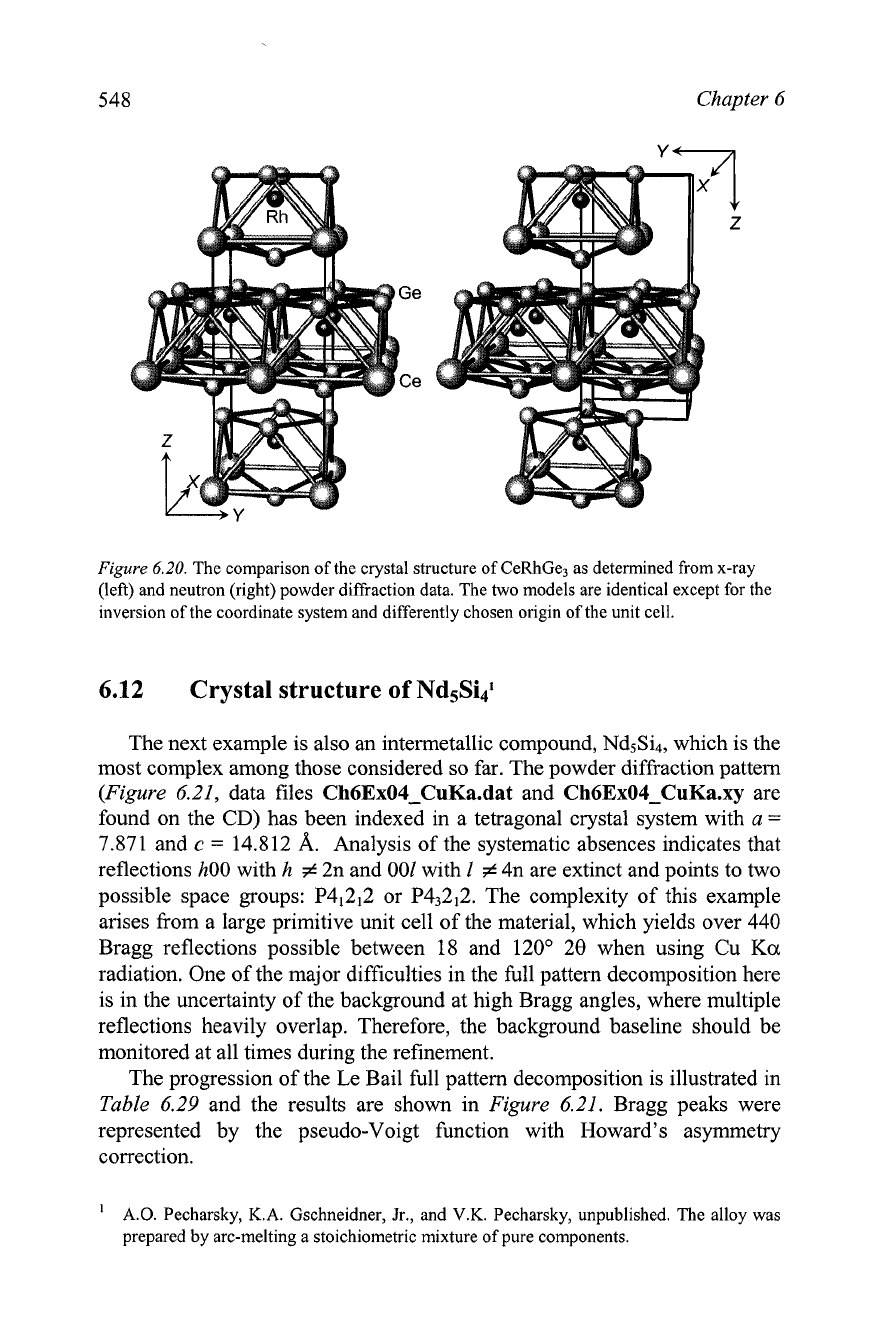
548 Chapter
6
Figure
6.20.
The comparison of the crystal structure of CeRhGe3 as determined from x-ray
(left) and neutron (right) powder
diffraction
data. The two models are identical except for the
inversion of the coordinate system and differently chosen origin of the unit cell.
6.12
Crystal structure
of
Nd5Si41
The next example is also an intermetallic compound, Nd5Si4, which is the
most complex among those considered so far. The powder diffraction pattern
(Figure 6.21, data files
Ch6ExO4-CuKa.dat
and
Ch6Ex04-CuKa.xy
are
found on the
CD)
has been indexed in a tetragonal crystal system with a
=
7.871 and
c
=
14.812
A.
Analysis of the systematic absences indicates that
reflections hOO with h
#
2n and 001 with 1
#
4n are extinct and points to two
possible space groups: P41212 or P43212. The complexity of this example
arises from a large primitive unit cell of the material, which yields over 440
Bragg reflections possible between 18 and
120' 28 when using Cu
Ka
radiation. One of the major difficulties in the full pattern decomposition here
is in the uncertainty of the background at high Bragg angles, where multiple
reflections heavily overlap. Therefore, the background baseline should be
monitored at all times during the refinement.
The progression of the Le Bail full pattern decomposition is illustrated in
Table
6.29
and the results are shown in Figure 6.21. Bragg peaks were
represented by the pseudo-Voigt function with Howard's asymmetry
correction.
'
A.O.
Pecharsky,
K.A.
Gschneidner, Jr., and
V.K.
Pecharsky, unpublished. The alloy was
prepared by arc-melting a stoichiometric mixture of pure components.
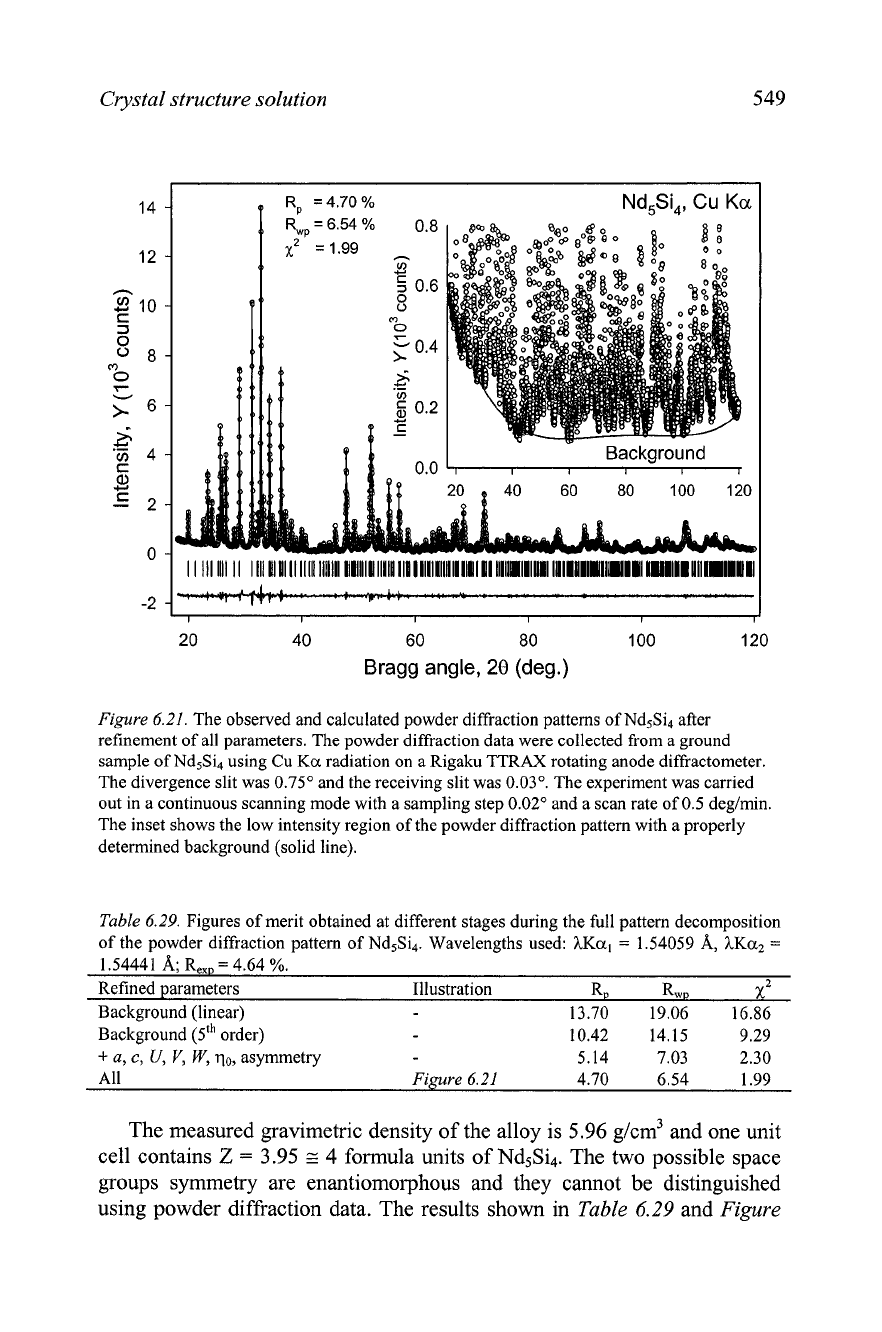
Crystal structure solution
549
20 40 60 80 100 120
Bragg angle,
20
(deg.)
Figure
6.21.
The observed and calculated powder diffraction patterns of Nd5Si4 after
refinement of all parameters. The powder diffraction data were collected from
a
ground
sample of Nd& using Cu
Ka
radiation on a Rigaku TTRAX rotating anode diffractometer.
The divergence slit was 0.75' and the receiving slit was 0.03'. The experiment was carried
out in a continuous scanning mode with a sampling step 0.02" and a scan rate of 0.5
deglmin.
The inset shows the low intensity region of the powder diffraction pattern with a properly
determined background (solid line).
Table
6.29.
Figures of merit obtained at different stages during the full pattern decomposition
of the powder diffraction pattern of Nd5Si4. Wavelengths used:
hKal
=
1.54059
A,
hKa2
=
1 .5444l
A;
Re,,
=
4.64
%.
Refined parameters Illustration R, RwD
x2
Background (linear) 13.70 19.06 16.86
Background (5th order) 10.42 14.15 9.29
+
a,
c,
U,
V,
W,
qo,
asymmetry 5.14 7.03 2.30
All
Figure
6.21
4.70 6.54 1.99
The measured gravimetric density of the alloy is 5.96 g/cm3 and one unit
cell contains
Z
=
3.95
z
4
formula units of Nd5Si4. The two possible space
groups symmetry are enantiomorphous and they cannot be distinguished
using powder diffraction data. The results shown in
Table
6.29
and
Figure
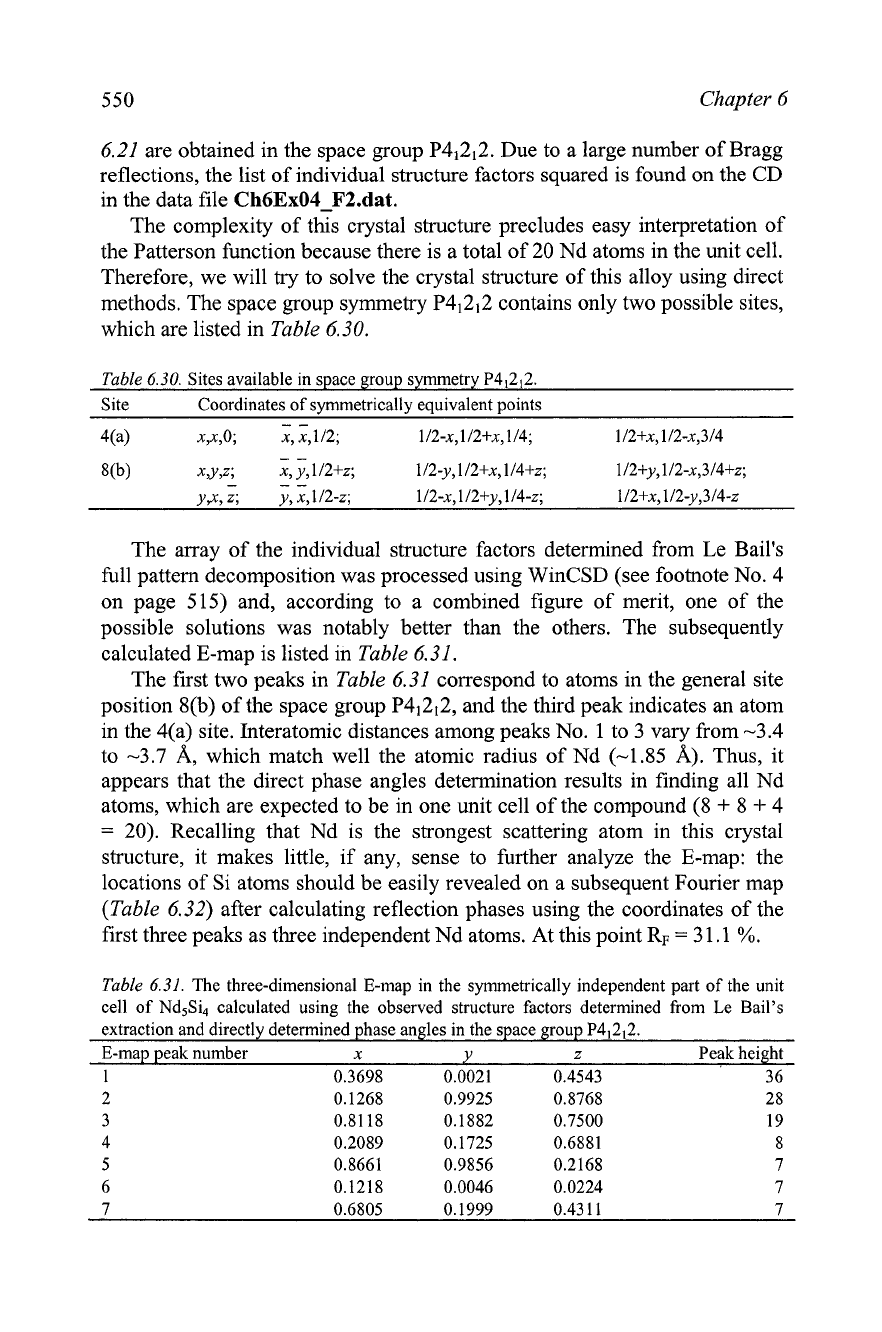
550 Chapter 6
6.21 are obtained in the space group P41212. Due to a large number of Bragg
reflections, the list of individual structure factors squared is found on the CD
in the data file
Ch6Ex04-F2.dat.
The complexity of this crystal structure precludes easy interpretation of
the Patterson function because there is a total of 20 Nd atoms in the unit cell.
Therefore, we will try to solve the crystal structure of this alloy using direct
methods. The space group symmetry
P41212 contains only two possible sites,
which are listed in Table 6.30.
Table
6.30.
Sites available in space group symmetry
P4!2!2.
Site Coordinates of symmetrically equivalent points
- -
4(a)
x,X,o; x, x, 112; 112-x, 1/2+x, 114; 1 /2+x, 112-x,3/4
The array of the individual structure factors determined from Le Bail's
full pattern decomposition was processed using WinCSD (see footnote No. 4
on page 515) and, according to a combined figure of merit, one of the
possible solutions was notably better than the others. The subsequently
calculated E-map is listed in Table
6.31.
The first two peaks in Table 6.31 correspond to atoms in the general site
position
8(b) of the space group P41212, and the third peak indicates an atom
in the 4(a) site. Interatomic distances among peaks No. 1 to 3 vary from -3.4
to -3.7 A, which match well the atomic radius of Nd (-1.85 A). Thus, it
appears that the direct phase angles determination results in finding all
Nd
atoms, which are expected to be in one unit cell of the compound (8
+
8
+
4
=
20). Recalling that Nd is the strongest scattering atom in this crystal
structure, it makes little, if any, sense to further analyze the E-map: the
locations of Si atoms should be easily revealed on a subsequent Fourier map
(Table 6.32) after calculating reflection phases using the coordinates of the
first three peaks as three independent Nd atoms. At this point
RF
=
3
1.1
%.
Table
6.31.
The three-dimensional E-map in the symmetrically independent part of the unit
cell of Nd5Si4 calculated using the observed structure factors determined from Le Bail's
extraction and directly determined phase angles in the space group
P4,2,2.
E-map peak number
x
Y
z
Peak height
1 0.3698 0.0021 0.4543 36
2 0.1268 0.9925 0.8768 28
3
0.81 18 0.1882 0.7500 19
4 0.2089 0.1725 0.6881 8
5 0.8661 0.9856 0.2168 7
6 0.1218 0.0046 0.0224
7
7 0.6805 0.1999 0.43 11 7
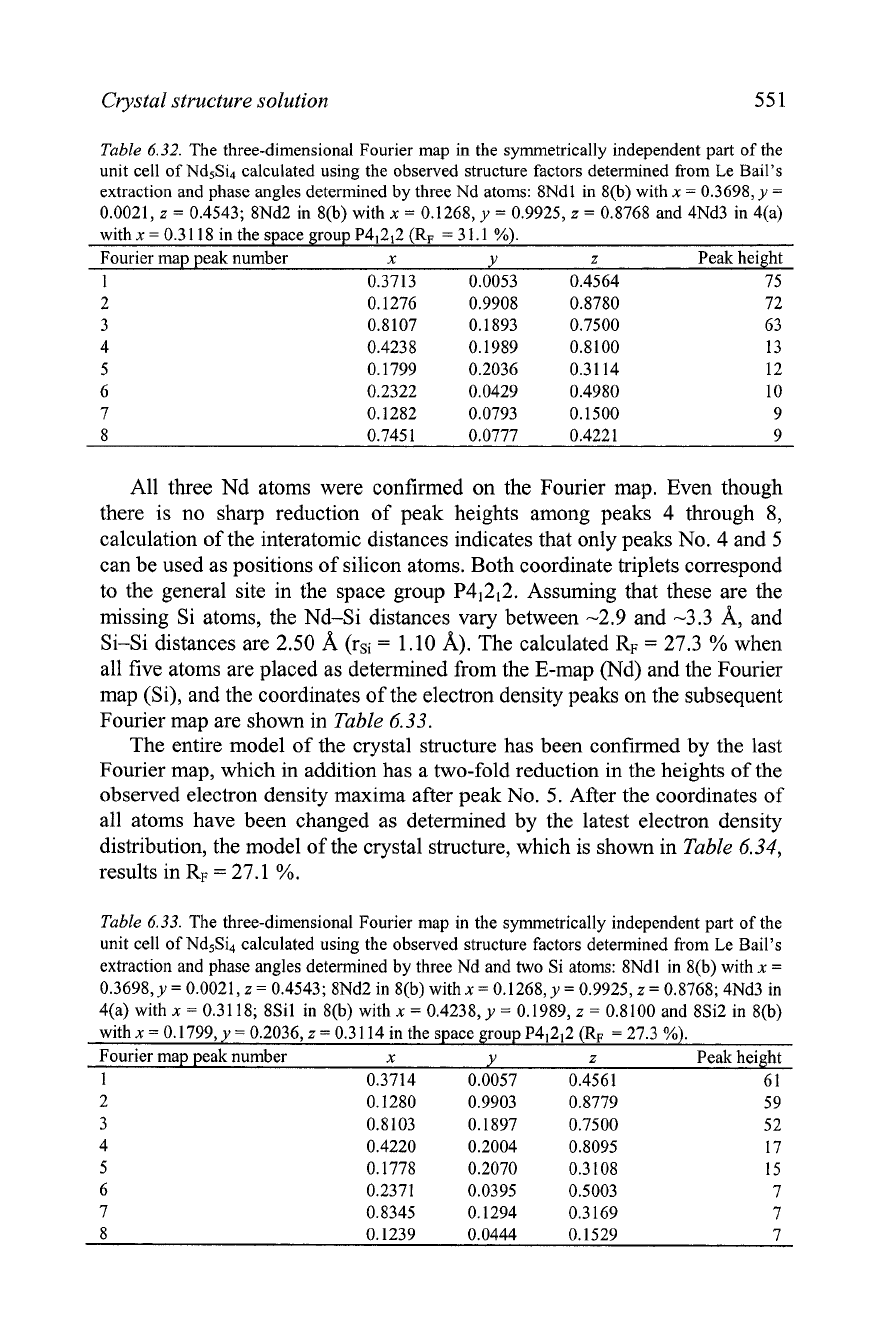
Crystal structure solution
55 1
Table
6.32.
The three-dimensional Fourier map in the symmetrically independent part of the
unit cell of Nd5Si4 calculated using the observed structure factors determined from Le Bail's
extraction and phase angles determined by three Nd atoms: 8Ndl in 8@) with
x
=
0.3698,
y
=
0.0021,
z
=
0.4543; 8Nd2 in 8(b) with
x
=
0.1268,
y
=
0.9925,
z
=
0.8768 and 4Nd3 in 4(a)
with
x
=
0.31 18 in the space group P41212 (RF
=
31.1
%).
Fourier map peak number
x
Y
z
Peak height
1 0.3713 0.0053 0.4564 75
2 0.1276 0.9908 0.8780 72
3 0.8107 0.1893 0.7500 63
4 0.4238 0.1989 0.8100 13
5 0.1799 0.2036 0.31 14 12
6 0.2322 0.0429 0.4980 10
7 0.1282 0.0793 0.1500 9
8 0.745
1 0.0777 0.4221 9
All three Nd atoms were confirmed on the Fourier map. Even though
there is no sharp reduction of peak heights among peaks 4 through
8,
calculation of the interatomic distances indicates that only peaks No. 4 and
5
can be used as positions of silicon atoms. Both coordinate triplets correspond
to the general site in the space group P41212. Assuming that these are the
missing Si atoms, the Nd-Si distances vary between -2.9 and -3.3
A, and
Si-Si distances are 2.50
A
(rsi
=
1.10 A). The calculated
RF
=
27.3
%
when
all five atoms are placed as determined from the E-map (Nd) and the Fourier
map (Si), and the coordinates of the electron density peaks on the subsequent
Fourier map are shown in
Table
6.33.
The entire model of the crystal structure has been confirmed
by
the last
Fourier map, which in addition has a two-fold reduction in the heights of the
observed electron density maxima after peak No. 5. After the coordinates of
all atoms have been changed as determined
by
the latest electron density
distribution, the model of the crystal structure, which is shown in
Table
6.34,
results in
RF
=
27.1
%.
Table
6.33.
The three-dimensional Fourier map in the symmetrically independent part of the
unit cell of Nd5Si4 calculated using the observed structure factors determined from Le Bail's
extraction and phase angles determined by three Nd and two Si atoms: 8Ndl in 8(b) with
x
=
0.3698,
y
=
0.0021,
z
=
0.4543; 8Nd2 in 8(b) with
x
=
0.1268, y
=
0.9925,
z
=
0.8768; 4Nd3 in
4(a) with
x
=
0.31 18; 8Sil in 8(b) with
x
=
0.4238,
y
=
0.1989,
z
=
0.8100 and 8Si2 in 8(b)
with
x
=
0.1799,
y
=
0.2036,
z
=
0.3 114 in the space group P4J12 (RF
=
27.3
%).
Fourier map peak number
x
Y
z
Peak height
1 0.3714 0.0057 0.4561 6 1
2 0.1280 0.9903 0.8779 5 9
3 0.8103 0.1897 0.7500 52
4 0.4220 0.2004 0.8095 17
5 0.1778 0.2070 0.3 108 15
6 0.2371 0.0395 0.5003 7
7 0.8345 0.1294 0.3169 7
8 0.1239 0.0444 0.1529 7
